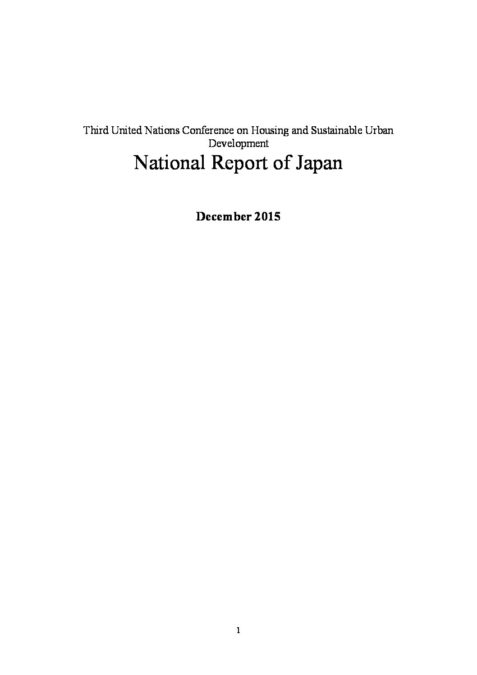

Japan
Urban indicators:
| Value | Year | ||
| Surface area (sq km) | 377930 | 2014 | Data refer to 1 October 2007. |
| Population (proj., 000) | 126324 | 2016 | |
| Pop. density (per sq km) | 346.5 | 2016 | |
| Capital city | Tokyo | 2015 | |
| Capital city pop. (000) | 38001 | 2015 | Major metropolitan areas. |
| Population growth rate (average annual %) | -0.1 | 2010-2015 | |
| Urban population growth rate (average annual %) | 0.6 | 2010-2015 | |
| CO2 emission estimates (000 tons/tons per capita) | 1243384/9.8 | 2013 | |
| Population using improved drinking water sources (urban/rural, %) | 100.0/100.0 | 2015 | |
| Population using improved sanitation facilities (urban/rural, %) | 100.0/100.0 | 2015 |
| 1995 | 2005 | 2014/2015 | |
| Urban population ('000) | 97,117 | 109,174 | 118,572 |
| Level of urbanization (%) | 78.0 | 86.0 | 93.5 |
National Report:
National Report Executive Summary:
1. Changes in the demographic structure and workforce in Japan
In 1950, Japan had a population of 84 million, which continued to increase, amounting to 100 million in 1967, peaking at 128 million in 2008, and took a downward turn. According to the National Institute of Population and Social Security Research (IPSS) the projected future population in Japan is expected to decrease at an accelerating rate and will be 97 million in 2050 (projections with medium-fertility scenario). The proportion of elderly people aged 65 or older of Japan’s overall population (the share of aged population) will increase from 5% in 1950 to 26% in2014, one of the highest shares in the world. The population will continue to age into the future, with the projected share of aged population reaching 40% in 2060.
The number of employed persons continued to increase from 41 million in 1955, before losing momentum in the late 1980s after the collapse of what is called the “bubble economy,” and peaked in 1997 at 66 million and took a downward turn. On a gender basis, the number of employed persons keeps decreasing among males, while the female figure has remained almost unchanged, leading to a continuing rise in the proportion of females among employees.
The demographic distribution is characterized by a rapid concentration in metropolitan areas since the 1960s, which was a period of high economic growth, and so far remains concentrated in particular in Tokyo metropolitan area, despite slowing down during the phase of stable economic growth in the mid-1970s. The proportion of the total population living in the three metropolitan areas reached 50% in 2010, with the Tokyo metropolitan area accounting for almost 30% of the Japanese population. In the future, amid the shrinking population for the entire country, the metropolitan areas are expected to attract a larger percentage of the population.
2. Policies for an aging society adapted to the needs of regional communities
(1) Overview of the policies regarding the aging society
The basic framework of Japan’s solutions to the aging society is based on the Basic Act on Measures for the Aging Society (hereinafter the “Basic Act,” enacted in 1995). With a view to pursuing solutions to the aging society in a comprehensive manner for the sound development of the economy and society, and the stability and improvement of people’s life, the Basic Act sets out the basic philosophy for solutions to the aging society as building a society that is fair and energetic, enables regional communities to be formed based on the spirit of self-sustaining and solidarity, and is affluent.
The Basic Act obliges the government to prepare the General Principles Concerning Measures for the Aged Society (hereinafter the “General Principles”) as basic and comprehensive guidelines for the government to pursue solutions to the aging society over the medium and long term. These General Principles were first formulated in 1996, before being revised in 2001, and the current General Principles were decided by the Cabinet in 2012.
As Japan is entering a super-aged society that no other nation has yet experienced, the General Principles have been formulated for the purpose of asking elderly people to support the society when they have the will and ability to do so, while, when in need of support, encouraging people around them to help them continue living the independent life that they deserve as members of the society and to realize a super-aged society that secures dignity for the elderly, and at the same time building a society in which all the generations help each other, so that everyone can bring their determination and abilities into full play.
Following the lines of the Basic Act, the General Principles set out six basic policies, the government adopts in pursuing solutions to the aging society, as follows:
1) Changing the awareness and the definition of “the elderly”;
2) Establishing a social security system that promises people security in their old age;
3) Making effective use of the motivation and abilities of the elderly;
4) Enhancing the capability of regions, and establishing stable communities;
5) Realizing safe and secure living environments; and
6) Preparing people for senior status from their youth in the “age of a 90-year lifetime.”
(2) Promotion of home medical and long-term care that copes with aging
With a rapidly aging and shrinking population in Japan, the share of aged population is expected to increase from 26% in 2014 to 30% in 2025. Moreover, the number of elderly people with dementia is increasing as well as households without young members. Meanwhile, 70% of the Japanese people expect to receive medical care at home even at the end-of-life stage as long as they are in a stable condition. These facts have led to forecasts that the demand for home medical and long-term care services will grow further, and thus there is an immediate need for reform of the system for providing medical and long-term care.
Under the Amendatory Law to the Related Acts for Securing Comprehensive Medical and Long-term Care in the Community, enacted in 2014, this reform is under way to provide people with home medical and long-term care in an integrated manner through role allotment of medical institutions and a seamless process from hospitalization to home care. The goal is to establish an integrated community care system, which should allow people, even those in a condition requiring a high level of care, to continue living their own way of life in the community where they have long lived by providing them with medical care, long-term care, preventive long-term care, housing, and daily-life assistance services in an integrated manner.
The integrated community care system must be prepared by a municipal government for a daily-life zone, defined as an area where people can access services they need within roughly 30 minutes, with respect for the autonomy and self-determination of the community and according to its actual conditions. An example of such a system is found in Toyoshikidai, a district in Kashiwa City, Chiba Prefecture (a municipality of 407,000 residents, located near Tokyo). In Toyoshikidai, housing complexes have been rebuilt in order to provide elderly people with houses where home medical and long-term care services are available. This system is based on the cooperation of the Kashiwa City government, the Urban Renaissance Agency, and the University of Tokyo with the help of the local medical association that provides home medical services and private-sector long-term care companies that have opened their offices there.
3. Policies for gender issues and opportunities for women
Under the Third Basic Plan for Gender Equality, decided by the Cabinet in 2010, the government is working to pursue policy programs for establishing a gender-equal society in a comprehensive and systematic manner. This Basic Plan, mentioning “regional development, disaster prevention, environment, and others” as one of its priority fields, promotes gender equality in communities by, for instance, encouraging them to see community development, revitalization of the local economy, and other activities from the viewpoint of gender equality.
Based on the experience of the Great East Japan Earthquake in March 2011, and other disasters, “Guidelines for Disaster Planning, Response and Reconstruction from a Gender-Equal Perspective” were drawn up in 2013. The Guidelines state that reconstruction plans and post-earthquake town reconstruction must reflect the viewpoint of gender equality.
4. Youth development and education
Under the Act on Promotion of Development and Support for Children and Young People, and the Outline for the Promotion of Development and Support for Children and Young People, the government is working for these purposes in a comprehensive manner. The Act has the basic idea that for the development and support of children and young people, families, schools, business establishments, local communities, and any other member of the society in any field must perform their own roles and work as one, in cooperation with each other. The philosophy constitutes the basis on which the ministries and agencies concerned implement their policy programs.
The Second Basic Plan for the Promotion of Education, decided by the Cabinet in 2013, is designed to provide local institutions for higher education with support in education, research and the social contribution activities they perform on an institution-wide basis, with the focus placed on local communities, for promoting interaction between these institutions and their communities and enhancing their functions as a Center of the Community (COC) that the communities can rely on. Under the plan, many universities are working with local communities and the society in general in various ways to help them solve their problems. For instance, universities are contributing through efforts including: curriculum reforms aimed at cultivating abilities of students themselves to find and solve local issues, revitalization of local communities through community developments for tourism in collaboration with local firms etc., and establishing authorization systems for learning fruits that can be utilized in employment examinations in collaboration with local communities for the purpose of promoting students’ settlements in their home towns. For the rehabilitation and revitalization of the local communities described above, the government also supports universities in excellent education and research activities that they perform to supply human capital that can work to solve problems which the local communities are faced with.
The government is also working to promote the Community School system (School Management Council System), a program that involves parents and other residents of a district in the management of a school to use the resources they have in developing a “school that goes with the local community” and solve problems that children have on a community-wide basis for providing quality school education. A school designated by the Board of Education as a Community School sets up a School Management Council composed of some parents and other residents of the district, and the Council has certain authority over the management of the school. Under the Community School system, many schools have achieved excellent results in solving challenges in student guidance and helping students raise their scholastic abilities. The Second Basic Plan for the Promotion of Education sets the goal of increasing Community Schools to 10% of the public-run elementary and junior-high schools, or some 3,000, and efforts are underway to achieve the target.
5. Policies regarding the shrinking population in the regions
As stated above, Japan already saw its demographic peak in 2008, and has been entering the phase of a rapid population decrease. Studies of demographic changes based on 1 km grid squares demonstrate that in 2050, the population is estimated to decrease by more than half from the 2010 level in more than 60% of the inhabited grids, 20% of which will become non-inhabited. Larger decreasing rates are forecast in municipalities with a smaller population. Maintaining the basic services and facilities such as daily shopping, medical care, and so on is a challenge for the future.
6. Recent trends in lifestyle and demographic flows
Recent trends in regard to urban-rural demographic flows, and immigration into rural areas include, firstly “dual-region habitation,” a lifestyle of urban dwellers having another base for life in an agricultural, mountainous or fishing village. For instance, a person may work in Tokyo during the week and spend weekends in a farming village, or two or three months in another place every year. The idea brings benefits not only to people living in urban areas as it offers them many alternatives, but also to farming villages and other host areas with increased consumption and potential future growth in the residential population, and dual dwelling is expected, in particular, to trigger the regeneration process of the regions, especially for depopulated regions.
Secondly, various rural regions have initiated establishing “small stations.” Rural communities in depopulated areas are seeing their schools and hospitals closed and transferred, and grocery and other daily goods stores are being forced out of business, leaving it difficult for the residents to continue living there. A “small station” is set up in such rural area to bring together stores, clinics, and other functions that people cannot live without in daily life, together with the venues they use for social events in the community, within walking distance. Basic services for daily life can be made easily accessible just like “one stop services” for local inhabitants in surrounding areas including the elderly population with no car, by providing community bus services and other means of public transport linking neighboring communities to the “small station,” which will also create opportunities to meet and talk with other people, as an additional benefit. Some of the small stations are being used as the market places to promote local specialties and obtain income from outside the community, which are good practices towards developing sustainable regional communities.
7. Towards a new urban agenda
The current birthrate and demographic shifts, assuming that they remain unchanged into the future, will inevitably lead to a sharp decline in the population and an uneven distribution of people between regions. High-level urban functions can be maintained only where a certain size of population is secured. A significant number of urban functional areas are forecast to fail to maintain their population above 300,000, other than the three metropolitan areas. Recovering the birthrate is an urgent challenge for stemming the decline in the population, while another concern is the continuing flow of young generations leaving the rural regions with a relatively high birthrate and coming into the Tokyo Metropolitan Area, characterized by a low fertility rate.
In non-metropolitan regions, the number of the elderly people, defined as those aged 65 or older, will peak in 2025, while that in the Tokyo metropolitan area will go beyond 10 million in 2035, and continue increasing through 2050. Large cities and the suburbs will thus see a rapid growth in the elderly population, leading to a larger mismatch as nursing institutions and other services will be in short supply in metropolitan areas, while other regions will have surpluses.
The government will thereby pursue the policies listed below, for example, during the period of a new urban agenda.
• The government will strive to expand the healthy life span of elderly people by encouraging them to work in various regions by making effective use of their rich knowledge, experience, and skills and to live in countryside while they are in good health. For this purpose, government agencies should work together with private-sector organizations, NPOs, and various other entities to promote dissemination of the information necessary to start country life or to find a home in the countryside, while a growing number of the population will be urban dwellers born in urban areas, who have no background of living in rural areas.
• The government is striving both to build a society that enables young people to stay and work in the regions, and help to generate flows of people coming from metropolitan areas to rural areas, and to promote creating regions friendly to elderly people living in metropolitan areas and hoping to move to rural areas where medical, nursing and other services are made available.
• Gender equality is a basic condition to raise the birthrate and develop sustainable local communities. Government will thus further improve the conditions for both men and women to share the experience of working and raising children together, either in large cities or regions, so as to increase female participation in the society, by creating regions where young people can find a job and bring up children and by promoting diverse and flexible styles of working and a sound work-life balance, in metropolitan and other urban areas.
• Urban functions should be consolidated by building a consensus among the communities concerned so that administrative services can be streamlined and economic activities stimulated. Collaboration between neighboring communities will be explored, which enables them to share functions and complement each other.
• Government continues promoting country life and “dual-region habitation” and the creation of “Small stations” in rural regions.
Statistics:
Basic services and infrastructure
Urban population with access to safe drinking water (%)
Urban population with access to adequate sanitation (%)
Urban population with access to regular waste collection (%)
Statements by Japan:
-
PrepCom3
-
PrepCom2
-
PrepCom1
-
Habitat III Plenaries
-
Intersessionals: Open-ended Informal Consultative Meetings
-
Intersessionals: Informal Intergovernmental Meetings (May 2016)
Events:
- At the Habitat III Conference:

- More events:

Seminar: Habitat III – Towards a New Urban Agenda

Seminar: From Sendai to Quito. Policy and Implementation on Urban Resilience



